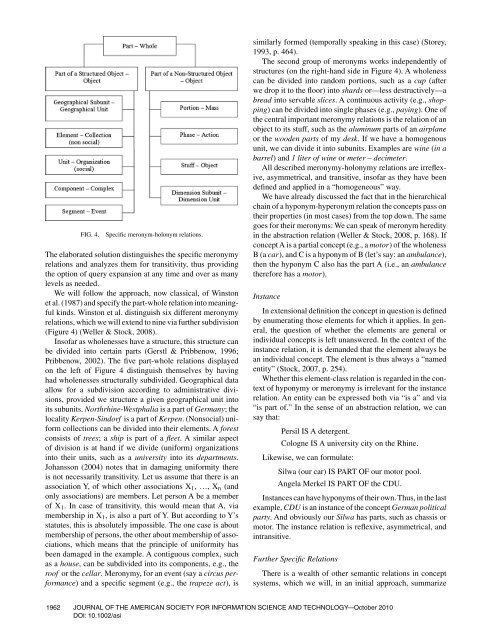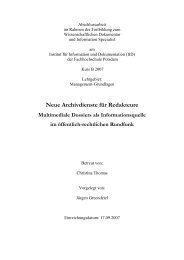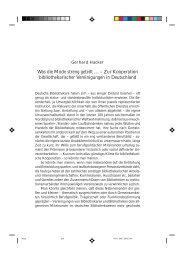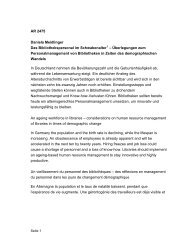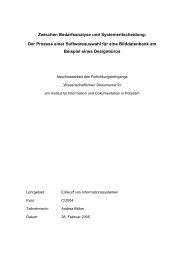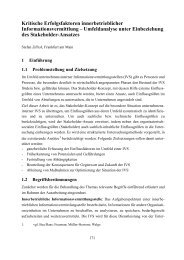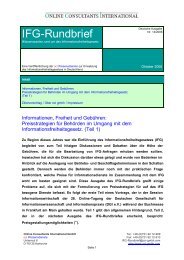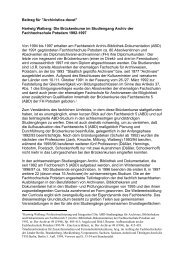PDF(886K) - Wiley Online Library
PDF(886K) - Wiley Online Library
PDF(886K) - Wiley Online Library
Create successful ePaper yourself
Turn your PDF publications into a flip-book with our unique Google optimized e-Paper software.
FIG. 4. Specific meronym-holonym relations.<br />
The elaborated solution distinguishes the specific meronymy<br />
relations and analyzes them for transitivity, thus providing<br />
the option of query expansion at any time and over as many<br />
levels as needed.<br />
We will follow the approach, now classical, of Winston<br />
et al. (1987) and specify the part-whole relation into meaningful<br />
kinds. Winston et al. distinguish six different meronymy<br />
relations, which we will extend to nine via further subdivision<br />
(Figure 4) (Weller & Stock, 2008).<br />
Insofar as wholenesses have a structure, this structure can<br />
be divided into certain parts (Gerstl & Pribbenow, 1996;<br />
Pribbenow, 2002). The five part-whole relations displayed<br />
on the left of Figure 4 distinguish themselves by having<br />
had wholenesses structurally subdivided. Geographical data<br />
allow for a subdivision according to administrative divisions,<br />
provided we structure a given geographical unit into<br />
its subunits. Northrhine-Westphalia is a part of Germany; the<br />
locality Kerpen-Sindorf is a part of Kerpen. (Nonsocial) uniform<br />
collections can be divided into their elements. A forest<br />
consists of trees; aship is part of a fleet. A similar aspect<br />
of division is at hand if we divide (uniform) organizations<br />
into their units, such as a university into its departments.<br />
Johansson (2004) notes that in damaging uniformity there<br />
is not necessarily transitivity. Let us assume that there is an<br />
association Y, of which other associations X1, …,Xn (and<br />
only associations) are members. Let person A be a member<br />
of X1. In case of transitivity, this would mean that A, via<br />
membership in X1, is also a part of Y. But according to Y’s<br />
statutes, this is absolutely impossible. The one case is about<br />
membership of persons, the other about membership of associations,<br />
which means that the principle of uniformity has<br />
been damaged in the example. A contiguous complex, such<br />
as a house, can be subdivided into its components, e.g., the<br />
roof or the cellar. Meronymy, for an event (say a circus performance)<br />
and a specific segment (e.g., the trapeze act), is<br />
similarly formed (temporally speaking in this case) (Storey,<br />
1993, p. 464).<br />
The second group of meronyms works independently of<br />
structures (on the right-hand side in Figure 4). A wholeness<br />
can be divided into random portions, such as a cup (after<br />
we drop it to the floor) into shards or—less destructively—a<br />
bread into servable slices. A continuous activity (e.g., shopping)<br />
can be divided into single phases (e.g., paying). One of<br />
the central important meronymy relations is the relation of an<br />
object to its stuff, such as the aluminum parts of an airplane<br />
or the wooden parts of my desk. If we have a homogenous<br />
unit, we can divide it into subunits. Examples are wine (in a<br />
barrel) and 1 liter of wine or meter – decimeter.<br />
All described meronymy-holonymy relations are irreflexive,<br />
asymmetrical, and transitive, insofar as they have been<br />
defined and applied in a “homogeneous” way.<br />
We have already discussed the fact that in the hierarchical<br />
chain of a hyponym-hyperonym relation the concepts pass on<br />
their properties (in most cases) from the top down. The same<br />
goes for their meronyms: We can speak of meronym heredity<br />
in the abstraction relation (Weller & Stock, 2008, p. 168). If<br />
conceptA is a partial concept (e.g., a motor) of the wholeness<br />
B(acar), and C is a hyponym of B (let’s say: an ambulance),<br />
then the hyponym C also has the part A (i.e., an ambulance<br />
therefore has a motor).<br />
Instance<br />
In extensional definition the concept in question is defined<br />
by enumerating those elements for which it applies. In general,<br />
the question of whether the elements are general or<br />
individual concepts is left unanswered. In the context of the<br />
instance relation, it is demanded that the element always be<br />
an individual concept. The element is thus always a “named<br />
entity” (Stock, 2007, p. 254).<br />
Whether this element-class relation is regarded in the context<br />
of hyponymy or meronymy is irrelevant for the instance<br />
relation. An entity can be expressed both via “is a” and via<br />
“is part of.” In the sense of an abstraction relation, we can<br />
say that:<br />
Persil IS A detergent.<br />
Cologne IS A university city on the Rhine.<br />
Likewise, we can formulate:<br />
Silwa (our car) IS PART OF our motor pool.<br />
Angela Merkel IS PART OF the CDU.<br />
Instances can have hyponyms of their own. Thus, in the last<br />
example, CDU is an instance of the concept German political<br />
party. And obviously our Silwa has parts, such as chassis or<br />
motor. The instance relation is reflexive, asymmetrical, and<br />
intransitive.<br />
Further Specific Relations<br />
There is a wealth of other semantic relations in concept<br />
systems, which we will, in an initial approach, summarize<br />
1962 JOURNAL OF THE AMERICAN SOCIETY FOR INFORMATION SCIENCE AND TECHNOLOGY—October 2010<br />
DOI: 10.1002/asi


